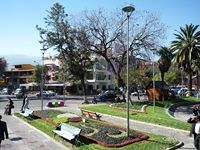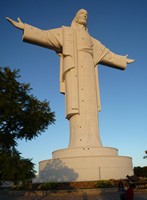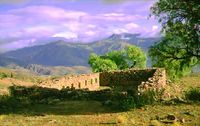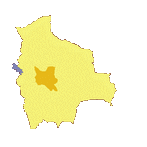A pleasant city
 The name
Cochabamba
The name
Cochabamba ![]() originates from the Quechua word "khocha"
(marsh, lake) and "pampa" (plain).
originates from the Quechua word "khocha"
(marsh, lake) and "pampa" (plain).
Cochabamba is located approximately 400km East of La Paz at an altitude of 2560 meters, surrounded by green hilly plains. To the North-West, the city is dominated by Cerro Tunari (5030m), the highest peak in this central area of Bolivia.
Cochabamba offers a particularly pleasant climate - hot and sunny during most of the year, with an average temperature of 18 degrees celsius. This moderate climate governs the local agriculture: corn, wheat, barley, citrus fruits, Coca.
Cochabamba benefits from a central geographical position at the crossroads of the principal towns of Bolivia (La Paz and Oruro to the West, Santa Cruz to the East, Sucre, Potosi and Tarija to the South).
Some key historical facts
Cochabamba was founded in 1574 by Sebastian Barba de Padilla, a few years after the foundation of the fabulously rich town of Potosí (known the world over for its silver mines).
During the wealthy periods of Potosí, Cochabamba also thrived by providing food to the miners of Potosí.
In the XVIIIth century, the size of Potosí declined as her mineral wealth was exhausted. Cochabamba inevitably suffered a similar economic decline.
In the middle of the XIXth century, the economic situation of Cochabamba recovered, and once again the city claimed its dominant position in agriculture (mainly cereals) at the national level.
The last days of Ché Guevara
 Born on June 14, 1928 in Argentina, Ernesto Rafael Guevara, called the "Che", believed that idealism, sacrifice and
revolution were a necessary way to attain equality for the masses. When he was a teenager, Guevara did not show a
particular interest for politics, in spite of the anti-peronist positions of his mother. At the age of 19, he started
to read documents from Marxists in the company of his girlfriend Berta Gilda Infante who was a member of Argentinian
Communist Youth.
Born on June 14, 1928 in Argentina, Ernesto Rafael Guevara, called the "Che", believed that idealism, sacrifice and
revolution were a necessary way to attain equality for the masses. When he was a teenager, Guevara did not show a
particular interest for politics, in spite of the anti-peronist positions of his mother. At the age of 19, he started
to read documents from Marxists in the company of his girlfriend Berta Gilda Infante who was a member of Argentinian
Communist Youth.
In the Fifties, Guevara accomplished many trips through South America, during which he attentively observed the social problems which touch the poorest and continued his political education in contact with various revolutionary groups. In 1956, Guevara clandestinely arrived in Cuba with a group of combatants lead by Fidel Castro. After 3 years of guerrilla warfare, Castro and his men released Cuba from the dictatorship of Batista. Guevara remained the right arm of the Prime Minister Fidel Castro during several years, before quitting the Cuban political scene in 1965.
After having left Cuba, Ernesto Guevara travelled to Africa (Congo) and to South America (Bolivia). In 1966, he clandestinely entered Bolivia under the name of Adolfo Mena Gonzales. November 7, at the head of a small group of combatants mainly composed of Bolivians and Cubans, he founded the liberation army (ELNB: Ejército de Liberación Nacional de Bolivia). October 8, 1967, Che, who directed an antigovernment peasant revolt in the South-East of Bolivia, is captured in Quebrada del Yuro by Bolivian armed troops supervised by the CIA. Transported to the village of Higuera, he was imprisoned and sentenced to death on October 9 by the highest Bolivian authorities. The corpse of Che was transported to Valle Grande and was exposed to the press.
The photographs showing Che on his funeral bed reveal a frail man, weakened by chronic attacks of asthma and suffering from arthritis and malnutrition. But the image of a fighting rebel is what remains in most documents and all the souls. October 18, 1967, on Plaza of Revolución in Havana, Fidel Castro made his famous speech in homage to his friend "¡Hasta la Victoria Siempre!".
The bones of Ernesto Guevara discovered near the airport of Vallegrande were formally identified in July 1997 and transferred to a mausoleum in Santa Clara which was the first Cuban city released by Che in December 1958.
Historical Cochabamba

- The cathedral on Plaza 14 de Septiembre (1571)
- Multiple churches and convents
Convento of San Francisco
Convento of Santa Teresa
Church of la Recoleta -
Cristo de la Concordia
 : recent statue of the Christ, more than 33 metres high (1 metre per year of Christ),
copying the one in Rio de Janeiro.
: recent statue of the Christ, more than 33 metres high (1 metre per year of Christ),
copying the one in Rio de Janeiro. - Museums:
Archaeological museum (objects of pre-colombian period)
Museum of natural history and botanical garden
- Portales palace (1925) built for Simon Patiño, using wealth gained by exploitation of local tin resources.
Lively Cochabamba
 The city of Cochabamba is famous for its markets. One of the best is the
market of la Cancha
The city of Cochabamba is famous for its markets. One of the best is the
market of la Cancha ![]() , specialising in handicrafts and agricultural products.
, specialising in handicrafts and agricultural products.
Excursions around Cochabamba

- The Quillacollo Community, located 8km outside Cochabamba, is known for its annual pilgrimage on August 15 in honour of the Virgin of Urkupiña.
-
Inca-Rakay
 ruins, near Sipe Sipe village (30km South-West of Cochabamba), is built on the peak of the Serrania
de Tahuani which dominates Cochabamba valley.
ruins, near Sipe Sipe village (30km South-West of Cochabamba), is built on the peak of the Serrania
de Tahuani which dominates Cochabamba valley. - Incallacjta fortress: advanced post of the Inca army located approximately 140km to the East of Cochabamba.
- Tunari national park: hiking trail in the middle of temperate vegetation, typical of this region, providing a superb view of the Cochabamba valley and Cerro Tunari.
- Torotoro national park, located 200km South-East of Cochabamba: caves, cave paintings and fossilised dinosaur footprints.






